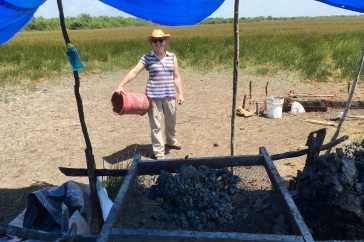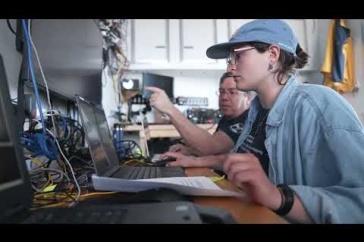 With the center’s assistance and grants, some 3,000 undergraduates have been taking their research to a new level since 1987.
With the center’s assistance and grants, some 3,000 undergraduates have been taking their research to a new level since 1987.
What’s the best way to help people with hand injuries get back to their daily activities?
What can salamanders tell us about the health of local streams?
Is there a greener way to turn algae into biodiesel?
These are a few questions that UNH students are exploring with help from the Hamel Center for Undergraduate Research, which celebrates its 25th anniversary this spring. Each year, the center awards grants to about 250 undergraduates, allowing them to experience firsthand what it means to conduct research in their fields. It has transformed undergraduate learning at UNH by allowing students in all disciplines and in all years to participate in research—both at UNH and around the world.
“The students instantly become not students but researchers, so they step up to a level of professional engagement that they don’t get in the regular classroom,” says Georgeann Murphy, the Hamel Center’s coordinator for international research. “It’s not just an academic exercise but the real thing.”
Indeed, these student researchers face many of the same challenges as their professional counterparts, from crafting a compelling proposal to working effectively with colleagues to dealing with setbacks. “You’re looking for something that’s never been discovered before, so you have to figure out your own problems,” says Tyler Burks ’12, who has received three grants from the Hamel Center to research avian immunology. “It’s not like in classes, where you can go to the back of the book for the answer.”
And when a project doesn’t go as planned, says Director Paul Tsang, “It should not be perceived that you failed because in real life research sometimes takes you in unexpected or different directions, and you may hit a wall. When that happens, you have to adjust, change course, and try again.”
Since its founding in 1987, the Hamel Center (originally named the Undergraduate Research Opportunities Program) has awarded more than 3,000 grants. In 2004, the center received an endowment from the Dana Hamel family, enabling it to support more students in collaboration with other campus units and to launch Inquiry, UNH’s first online journal of undergraduate research.
Most grant recipients present their research at the UNH Undergraduate Research Conference, the largest conference of its kind in the country. All of them work with faculty mentors, who say Hamel shows students they can make an impact early on. “It gives them confidence in their ability, that even as undergraduates they can do some excellent work, present their work at national conferences, receive prestigious fellowships, and help train other students once they’re more comfortable,” says Professor of Chemical Engineering Ihab Farag.
|
Ihab Farag, UNH professor of chemical engineering (right) worked with undergraduate research students (left to right) Brian McConnell, Becky Wilson, Gina Chaput, and Kyle Charmanski at the Energy, Utility, and Environment Conference in Phoenix. |
One of Farag’s students is Brian McConnell ’13, who has received Hamel support to research the best ways to grow algae for biodiesel production. He has successfully grown the algae in municipal wastewater, saving fresh water that could be used for crops or drinking, and in flexible plastic bags that can float on dead zones in the ocean. Last fall, McConnell—along with genetics major Gina Chaput ’13, who has also gotten support from Hamel—received a nearly $50,000 fellowship from the U.S. Environmental Protection Agency’s National Center for Environmental Research.
McConnell says his Hamel grants made his application stand out. “I not only said I was interested in alternative energy and helping the environment, I actually had done research in that area.”
Eric Dors ’92 can second that. He received Hamel support in 1991 to develop a more efficient way to calibrate instruments that measure the nature of the space environment. He believes his experience designing and building flight hardware at UNH, where he also earned M.S. and Ph.D. degrees in physics, led to his being hired as a post-doctoral research assistant at Los Alamos National Laboratory. “It opened up doors that wouldn’t have otherwise been opened,” says Dors, now leader of a Los Alamos team that makes and deploys satellite instruments to monitor nuclear test ban treaties. “No one wants to pay you to learn on the job if they don’t have to.”
Editor’s Note: This is the first in a three-part series looking at the impact of the Hamel Center on student learning. Next week’s story will focus on the Center’s international research opportunities.
|
Amy Ma '12 researched therapy designed to return patients to their daily activities. Photo by Mike Ross, UNH Photographic Services. |
Research Takes Her from Classroom to Community
Her father’s hand therapy inspires Amy Ma to investigate the most effective treatment for everyday living
When Amy Ma ’12 arrived at UNH as a first year-student, her idea of a researcher was someone who worked in a lab.
“I never considered doing research, ever,” Ma says. “It seemed very chemistry-oriented—and that’s not me.”
As a sophomore, however, the occupational therapy major decided she wanted to pursue summer work in her field and applied for a Summer Undergraduate Research Fellowship. Working with a faculty mentor, Associate Professor of Occupational Therapy Barbara White, she examined whether pregnant women who took part in stress-reducing activities reported better social relationships. Analyzing previously collected data, she did not find a link between decreased stress and quality of social supports. However, the data did show that the activities lowered the women’s stress.
The experience inspired her to apply for a second summer research grant to carry out her own project. Ma had become interested in upper-extremity therapy during her first year at UNH, when her dad underwent hand therapy. “It got me thinking how you need your hands for so many things,” she says.
Last summer, Ma investigated whether people recovering from hand injuries are more satisfied with therapy that takes into account their jobs and everyday activities. She’s now analyzing data from online surveys that she designed and administered to therapists and their clients. Her findings will become the basis for her senior honors thesis.
Ma says she has not only discovered that research isn’t limited to the bench sciences, but also that it can be rewarding. “It’s very cool to me to be able to think critically—and not just ask a question, but ask a question and be able to pull my resources and come up with my own answer.”
Ma, who’s applying to master’s programs in occupational therapy, presented her research at last year’s UNH Undergraduate Research Conference and the annual conference of the American Occupational Therapy Association (AOTA). She plans to continue attending AOTA conferences as a practicing clinician and says that her research background will help her get the most out of the experience. “I feel like I’ll be more part of the conversation as opposed to an outsider looking in.”
|
Adam Marquis ’12 measured salamander populations to look for links to water quality. Photo by Lisa Nugent, UNH Photographic Services. |
Salamander Research Offers Insights on Water Issues
Adam Marquis traversed miles of woods and wetlands to study fluctuations in salamander populations
Adam Marquis ’12 devoted his summer to counting salamanders at 32 sites, from the seacoast town of Rye to Moose Mountain near Lake Winnipesaukee.
“It was really, really cool,” says Marquis, a wildlife and conservation biology major. “I spent my whole summer outside wading around in streams.”
But Marquis was doing serious work: He’d received a Summer Undergraduate Research Fellowship to investigate salamander population density in southeastern New Hampshire.
Because salamanders live in and near water and breathe through their skin, they’re easily affected by pollutants, making them an excellent indicator of environmental health. Marquis was surprised to catch more salamanders where human population density is high—including near the UNH campus—and fewer in in remote areas such as Pawtuckaway State Park.
He thinks that nearly acidic water in Pawtuckaway, caused by the dry summer, may explain the low salamander count there, whereas the streams near campus are generally in good shape. In addition to his salamander findings, he also made some discoveries about the research process. Marquis, who worked with UNH doctoral student Daniel Hocking, hadn’t appreciated that his time outdoors would be a relatively small part of his project. Before he could start counting salamanders, he needed to write a proposal, figure out his field methods, and scout sites to make sure streams hadn’t dried up. After finishing his fieldwork, Marquis spent many more weeks analyzing the data and writing a paper.
The project helped him realize that he could do ecology research and enjoy it, he says. He now plans to apply to master’s programs in herpetology. “I’ve always had a love for reptiles. I’d love to be able to work with them and study them.”
Originally published by:
UNH Today
WRITTEN BY SONIA SCHERR, ’13 MFA.

















































 With the center’s assistance and grants, some 3,000 undergraduates have been taking their research to a new level since 1987.
With the center’s assistance and grants, some 3,000 undergraduates have been taking their research to a new level since 1987.




